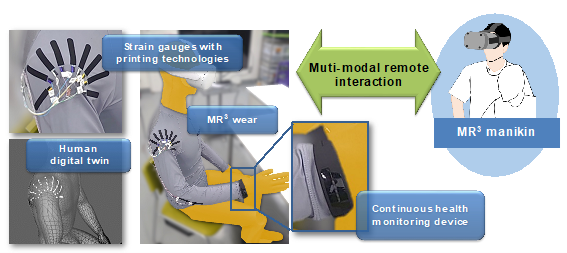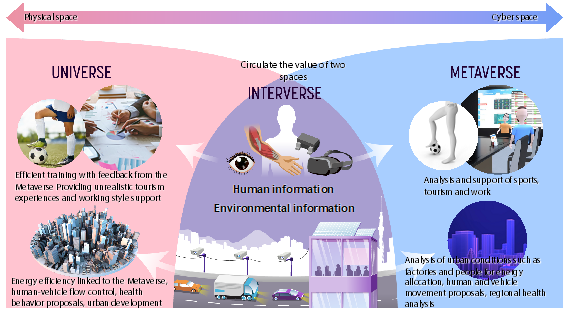Introduction
The Phygital World is a seamless connection between the physical world in which human lives as living organisms and the digital world in which digitalized humans and environments act. Through the Phygital World, humans can get freedom from the constraints of the physical world and can be Augmented Humans. For example, human will be able to move freely across time and space, be in multiple places at the same time, and be able to gather without spatial restrictions. Such Augmented Humans will change the manufacturing and maintenance, will also increase the value of various service industries such as tourism, customer service, nursing care, medical care, and education. The Phygital World can create Augmented Humans, therefore the Phygital World requires Human Augmentation technology.
The Human Augmentation Research Center of AIST defines Human Augmentation technology as "technologies close to human to enable human to live more actively." By wearing information technology and robot technology, humans' physical and psychological capabilities can be improved temporarily, and by continuing to use those technologies, those capabilities could be improved permanently. Figure 1 shows the technology map of human augmentation. Human functions are divided into four categories: physical function, sensation, cognition, and communication. Human Augmentation technology for the four functions are divided into three categories: measurement technology of functions, acceleration of each function, and remote control and scale-up through the digital space.
Fig.1. Technology map of human augmentation.
Human Augmentation and Metaverse
The "remote and scale-up" shown in Fig. 1 is realized by people being networked and entering the digital space (Metaverse). Human Augmentation and the Metaverse are not the same thing. Human Augmentation includes research that uses sensors and robot control to extend physical functions without use of the Metaverse, and research that extends communication functions with only sensors and AI. Here, concrete researches of Human Augmentation with active use of the Metaverse are introduced.
The first is research on customer service training support Building a digital twin of a family restaurant's real store in the Metaverse and reproduce virtual customers there. Trainees wearing VR goggles and hand gesture devices immerse themselves in the Metaverse and provide customer service to virtual customers. The second example is a study of remote care service support. A medical institution with professional physical therapists and a remote location with patients undergoing rehabilitation training each exist in the physical space (Universe). The physical therapist and the patient exist side by side in the same space in the Metaverse, and both the physical therapist and the patient feel each other's presence. By moving the body, the patient performs rehabilitation training while feeling the hands of the physical therapist.

Fig.2. Research project of Remote care service.
Towards Interverse Services
For people in the physical space (Universe) to enter the digital space (Metaverse), and for the value co-created in the Metaverse to flow back to the people in the Universe, technology that connects the Universe and the Metaverse seamlessly is required. That is Interverse technology (Fig.3). We believe a new market of Interverse Services for training, health support, care, tourism, work support and smart cities could be established through the interaction between the Universe and the Metaverse using Interverse technology.

Fig.3 Interverse
Coordinated actions in five perspectives are required to establish the market of Interverse Services. The first is basic technology research. Interverse technology that connects the five senses, or technology that connects the brain, especially interface technology that circulates from the Metaverse to the Universe is important. In addition, research on data architecture for the Metaverse and development of APIs for Interverse technology will also be necessary. The second is rule formation. Standards for interoperability of Interverse technology and data portability, performance standards and process standards for quality control of Interverse services must also be established. Moreover, rules on the use of Metaverse data (protection of personal information, privacy) and safety standards to control negative aspects such as addictiveness and biosafety should be established. As the third. development of a business model under the standardization strategy is important. The fourth is social acceptability. The fifth is the perspective of human resource development for the Interverse Services.
Conclusion
Based on Human Augmentation technology and Interverse technology, a new market of the Interverse Services could be established in forthcoming the Phygital World. In Japan, from April 2023, the third phase of the SIP (Cross-ministerial Strategic Innovation Promotion Program), a national research and development project promoted by the Cabinet Office, began. The theme of the program "Development of basic technologies and rules for the expansion of the virtual economy" was selected as the SIP programs. The author is the program director. In this program, more than 10 projects aimed at Interverse Services will be adopted, and research and development based on the above five action plans will be promoted in a five-year plan.


